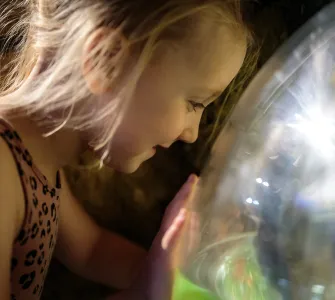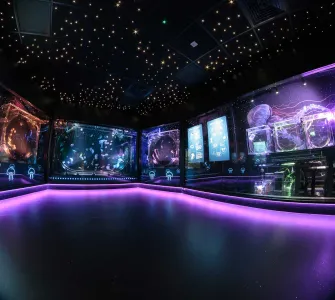February 2023 marks the six-year anniversary of bringing our two Loggerhead sea turtles, Senza and Mabouche, into The Deep family.
I have been lucky enough to work with them from the very beginning and have seen what a big impact they have had from our very first meeting in Belgium through to today. Senza and Mabouche quickly became guest favorites. Mabouche is typically front and center, as her preferred resting place is on view at the main window of our Endless Oceans habitat, and you can typically find Senza making her rounds around the habitat, often interacting with guests at the viewing windows. Providing a home for these two amazing rescue turtles goes beyond giving them a space to thrive when they could not be released back into the ocean. The turtles are great ambassadors, allowing us to share not only their story, but also those that are affecting all the inhabitants of our oceans. We do this daily in conversations with our guests, more formally by giving presentations, and have developed interactive learning opportunities – such as our mock turtle hospital – that allows children to help us save sea turtles. We are also active members of the European Sea Turtle Working Group, which has allowed us to help develop a husbandry manual which sets standards for the best possible quality of care for sea turtles and to share knowledge with aquariums and zoos across Europe. Once we got our turtles settled in at The Deep, it was important for us to pursue a conservation project, so we set out to find one that we could be a part of. We were lucky enough to form a partnership with the New England Aquarium Rescue Center, which has been beneficial for staff and sea turtles alike!
After a two-year break because of Covid, The Deep was finally able to return this year to The New England Aquarium Rescue Center. Each year, hundreds of cold-stunned sea turtles strand on the beaches of Cape Cod outside of Boston, Massachusetts, USA. This phenomenon began with the rescue of a few turtles each year that were taken to the main aquarium building for rehabilitation and has grown to a rescue operation that helps hundreds of turtles a year and requires the existence of a dedicated Rescue Center and network of organizations to manage the strandings. The turtles find themselves in danger for multiple reasons, the largest being climate change and geography. The waters above Cape Cod Bay in the Gulf of Maine, are some of the fastest warming waters on the planet. This leads to patches of warm water in the area and along the East Coast that confuse the turtles, as they do not realize that the waters around the patches are steadily growing colder and that it is time for them to move south for the winter. This problem is compounded by the geography of the region. Cape Cod forms a hook shape around Cape Cod Bay and the turtles get trapped inside the Bay. Once inside, they struggle to navigate their way up and out around the hook to be able to move down the coast to warmer water. This is a major problem because most of the turtles effected are the critically endangered Kemp’s Ridley sea turtles. It is vitally important that these turtles are rescued to ensure the survivability of the species. The rescued turtles are juveniles, so without the help of organizations like The New England Aquarium Rescue Center, large numbers of juvenile turtles would be removed from the population each year, meaning they would never reach maturity to aid in the survival of the species. The Rescue Center also receives juvenile Green and Loggerhead sea turtles.
The Deep is lucky to be able to assist such a well-established and accomplished program. Each year we spend 3 weeks aiding the incredible staff at the Center. We help with everything from numbering and banding the turtles upon arrival to trying to get them to start eating. My personal favorite is helping in the clinic where most of the veterinary work happens. Clinic jobs range from holding turtles for exams or procedures, to drawing up and/or administering fluids and treatments. There are so many turtles at different stages of rehabilitation and all their care must be carefully coordinated. The Rescue Center runs under a predetermined structure that ensures good lines of communication so that all the staff, interns, and volunteers can work together like an orchestra directed by their conductor to keep things moving smoothly and provide care to the large number of turtles that pass through their doors. This comprehensive approach allows the turtles to get the important care they need and ensures that they are ready to get back into the ocean as soon as possible.
I am endlessly grateful to both The Deep and The New England Aquarium for all the amazing work that they do ensuring the survival of endangered sea turtles and allowing me to play a small part in it.



